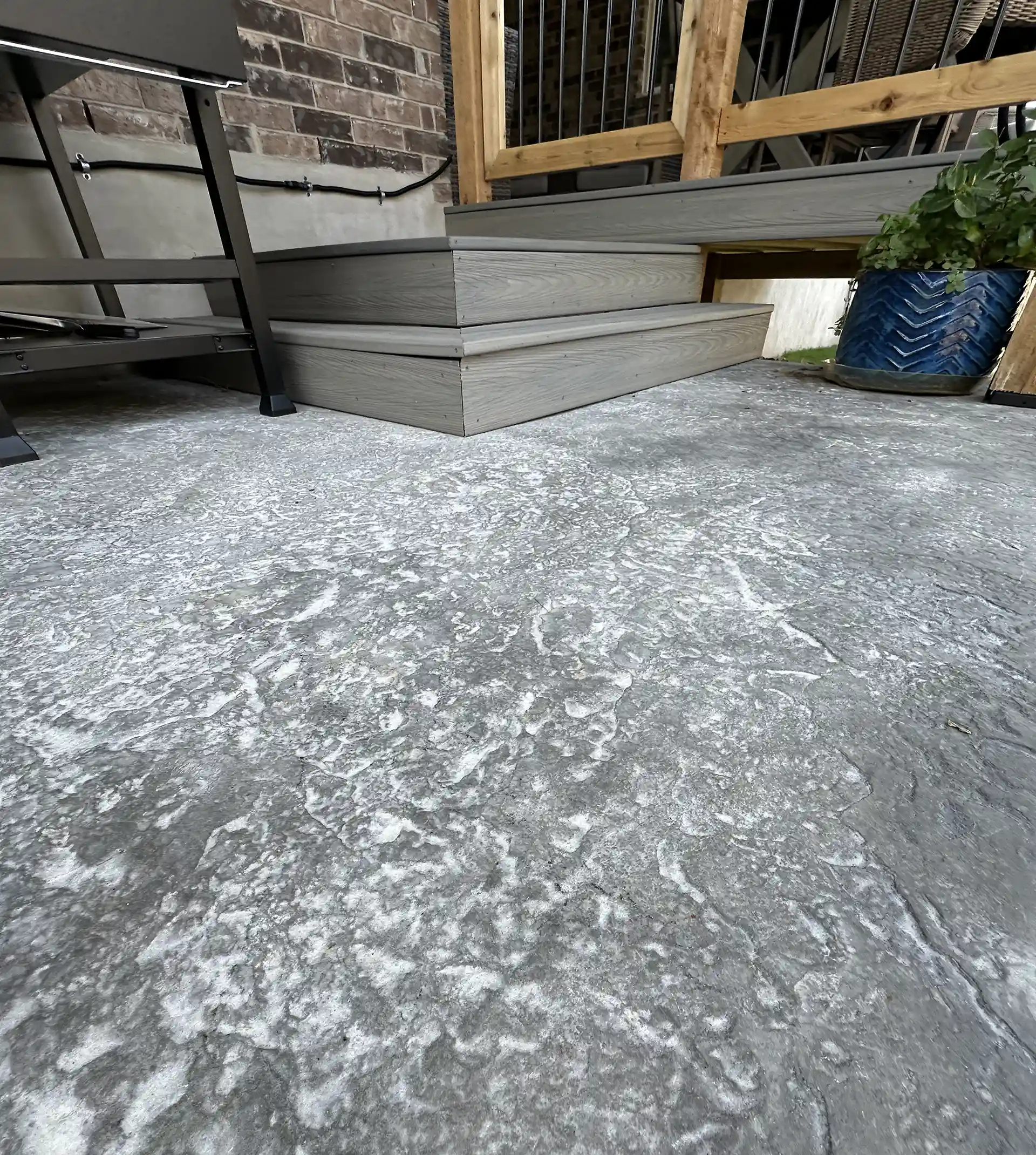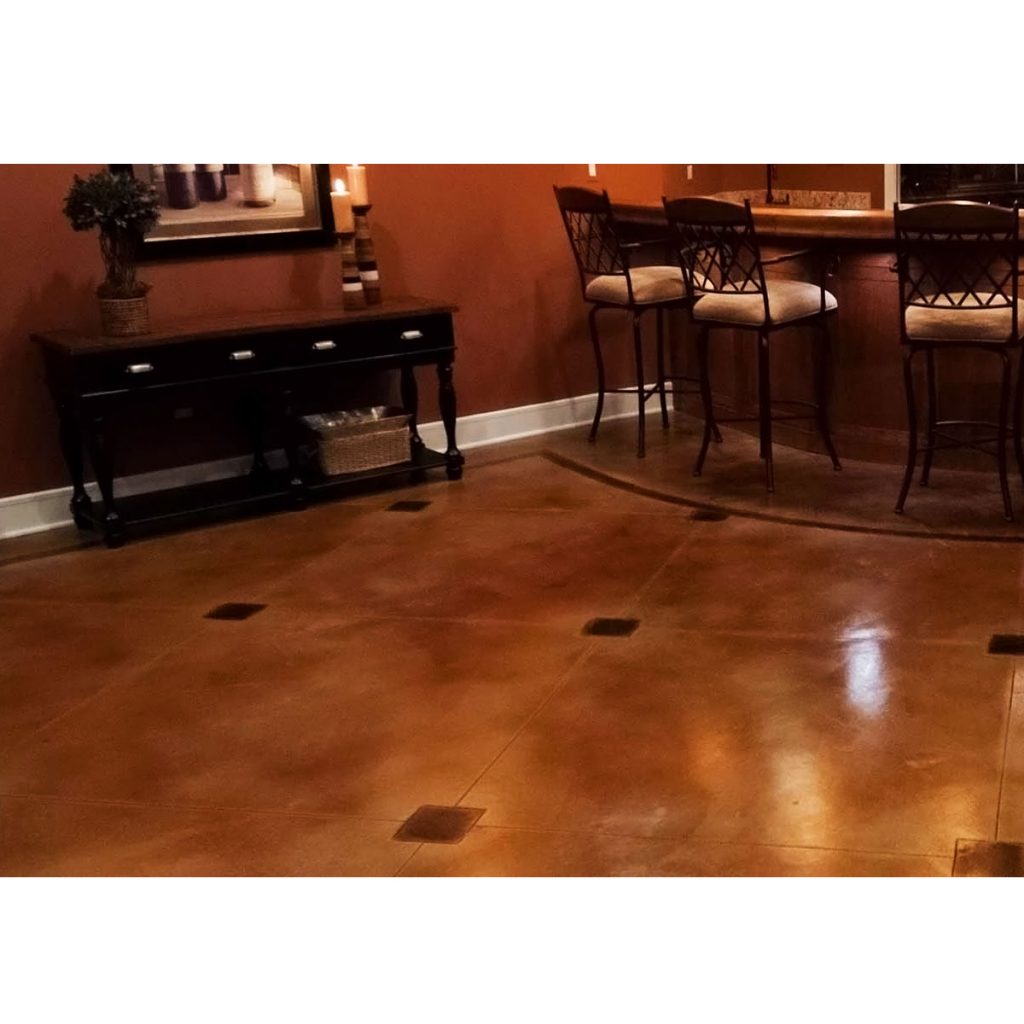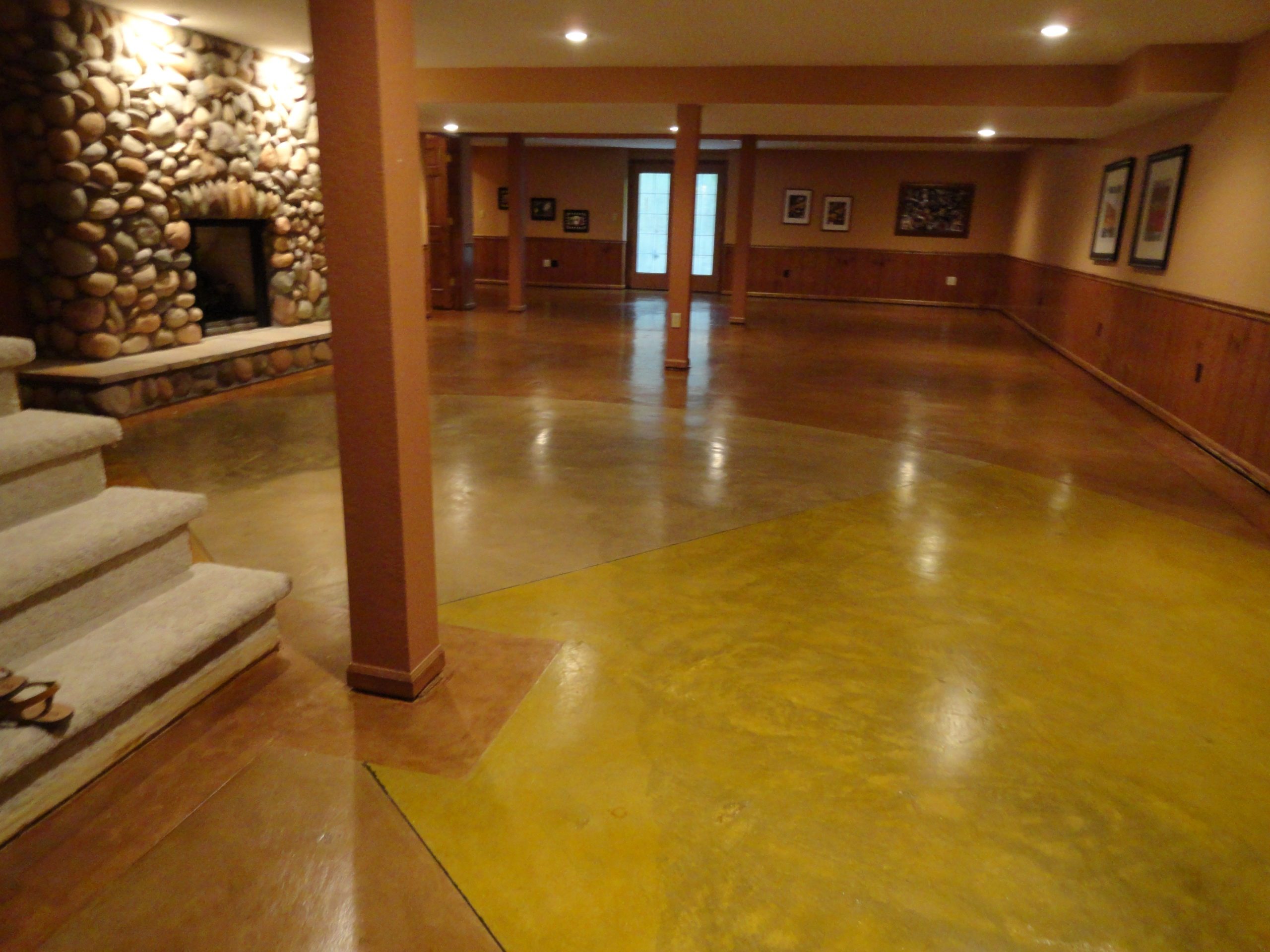Step-by-step process of color layering with stained concrete
Comprehending the Variety Of Providers Offered in Floor Covering: Highlighting Stained Concrete Techniques
Stained concrete has actually become an engaging floor covering option for various areas. Its flexibility lies in the option between acid and water-based spots, each using distinctive aesthetics. Correct prep work and continuous upkeep are vital to guarantee its longevity and look. As the demand for innovative floor covering solutions expands, comprehending the subtleties of tarnished concrete techniques could open brand-new opportunities for both property and commercial environments. What unique advantages might this flooring alternative give a task?
The Fundamentals of Stained Concrete
Stained concrete acts as a flexible flooring alternative that incorporates longevity with aesthetic charm. This flooring method includes using a particularly formulated stain to the concrete surface area, which penetrates and alters the shade of the product. The process not only boosts the aesthetic elements of concrete but additionally supplies the advantage of protecting it from wear and tear. Stained concrete can accomplish a wide variety of looks, from natural tones to dynamic colors, making it suitable for various design motifs.
Proper prep work of the concrete surface is important for suitable results. This might consist of cleansing, grinding, or engraving to ensure the stain adheres effectively. In enhancement, the application procedure normally entails making use of tools such as sprayers or brushes to accomplish consistent insurance coverage. After staining, a sealer is frequently put on improve sturdiness and keep the vibrancy of the shade. Eventually, discolored concrete gives an appealing and lasting flooring service for domestic and industrial rooms alike.
Kinds of Stains: Acid vs. Water-Based

In comparison, water-based spots offer a broader variety of colors and are easier to use. They do not respond chemically with concrete however rather supply a surface tint - stained concrete austin. Water-based stains are low in volatile organic substances (VOCs), making them a lot more eco-friendly and appropriate for indoor tasks. While they might not give the exact same deepness of shade as acid spots, their versatility and ease of usage make them appealing for various applications. Ultimately, the selection depends on the project's requirements, preferred visual appeals, and place
Strategies for Staining Concrete
The techniques for discoloring concrete vary significantly in between acid and water-based approaches. Acid staining includes a chain reaction that produces unique, variegated colors, while water-based stains offer a more comprehensive scheme and less complicated application. Comprehending these processes is essential for accomplishing the desired visual in concrete floor covering.
Acid Staining Refine
Acid staining uses a dynamic way to enhance the visual appeal of concrete surface areas. This procedure entails using a mix of water, hydrochloric acid, and pigments to the concrete, which responds chemically to generate vivid, translucent shades. First, the concrete surface area should be completely cleansed and prepped to ensure optimal adhesion. When applied, the acid stain passes through the concrete, creating distinct marbled impacts as it responds with the lime in the concrete. After the preferred color establishes, the surface is counteracted and washed to stop the reaction. Lastly, a sealant is applied to protect the finish and improve toughness. Acid staining not only changes the appearance of concrete however likewise provides a resilient service for ornamental floor covering.
Water-Based Staining Advantages
How can water-based staining elevate the visual and practical qualities of concrete surfaces? Water-based stains supply a functional remedy for improving concrete, giving dynamic color options while ensuring environmental safety. Unlike acid stains, water-based choices penetrate the surface, enabling also color distribution and a variety of coatings, from matte to glossy. In addition, they are reduced in volatile organic substances (VOCs), making them much less harmful to indoor air top quality. Their quick drying time helps with quicker task conclusion, while their resistance to fading ensures long-lasting charm. Water-based discolorations can likewise improve the concrete's toughness and resistance to discolorations, making them an ideal selection for both property and business applications. Inevitably, they give a lasting, eye-catching solution for different concrete surface areas.
Style Possibilities With Stained Concrete
Stained concrete deals a variety of design possibilities that can boost any kind of room. Strategies such as shade variation, different surface area completing choices, and personalized style patterns enable for special and tailored flooring options. These elements not only elevate appearances however also add to the overall capability of the concrete surface area.
Color Variant Techniques
While discovering the style opportunities of stained concrete, shade variant techniques play a critical duty in enhancing both visual charm and performance. These methods enable for the development of distinct patterns and effects that can transform an easy concrete surface area into an aesthetically striking element of a room. Alternatives such as acid staining, which reacts chemically with the concrete, create abundant, translucent hues that mimic natural stone. Water-based stains offer a more comprehensive color palette and permit for even more control in style. Moreover, layering various spots can create depth and measurement, providing a tailored look. By integrating color variant methods, developers can attain varied styles, from rustic to modern, making certain that discolored concrete fits flawlessly right into any kind of style system.
Surface Finishing Options
The expedition of shade variation techniques establishes the phase for thinking about surface completing alternatives, which considerably affect the overall appearance and capability of tarnished concrete. Different surfaces can improve the visual appeal and toughness of the surface. Typical options include matte, satin, and glossy finishes, each supplying an unique aesthetic result. Matte finishes offer a refined, downplayed style, while satin surfaces strike an equilibrium between luster and usefulness, making them prominent for household and industrial rooms. Glossy coatings, on the various other hand, produce a high-shine look, enhancing color vibrancy and light reflection. Additionally, surface treatments such as sprucing up or securing even more improve longevity, making these finishing options essential factors to consider in designing practical and aesthetically attractive tarnished concrete floors.
Custom Layout Patterns
Just how can customized design patterns raise the charm of discolored concrete? By including one-of-a-kind styles, discolored concrete can change normal flooring into a striking aesthetic statement. Customized patterns, such as official site geometric forms, detailed themes, or organic styles, enable personalization, making rooms feel customized and welcoming. Clients can pick from a range of methods, consisting of saw cuts, patterns, or overlays, to accomplish preferred effects. In addition, integrating multiple shades with different stain techniques boosts the depth and measurement of the patterns. These style opportunities not just improve aesthetic allure but additionally raise the value of household or business areas. Inevitably, custom-made design patterns offer a possibility for creative thinking, establishing stained concrete apart from conventional flooring alternatives.
Preparing Your Concrete Surface Area
Correct prep work of the concrete surface is important for achieving a successful tarnished finish. This procedure starts with detailed cleaning to eliminate dust, grease, and any type of other pollutants. A stress washing machine or a flooring scrubber can efficiently eliminate these compounds, guaranteeing a fresh start for staining. After cleansing, it is crucial to fix any kind of cracks or imperfections in the concrete. This can be accomplished using a concrete patching substance, which need to be permitted to cure fully before proceeding.
Once the surface is clean and repaired, grinding or sanding may be required to develop a smooth, also structure. This action improves the concrete's about his capability to soak up the stain uniformly. A concrete etcher can be used to open up the pores of the surface, enabling for far better attachment of the stain. By complying with these prep work actions, the resulting stained concrete will exhibit a more vibrant and long lasting finish
Maintenance and Care for Stained Concrete
Keeping tarnished concrete is necessary for preserving its look and longevity after the first prep work and application of stain. Normal cleaning is crucial; sweeping or vacuuming to get rid of dust and particles stops scrapes and dullness. For deeper cleansing, a moderate pH-neutral cleaning agent combined with water can be used, adhered to by extensive rinsing to prevent deposit accumulation.
Sealing stained concrete is an additional essential upkeep step, as it shields the surface from stains and moisture. Depending on the sealant kind, reapplication may be essential each to three years. In addition, preventing harsh chemicals and rough devices helps preserve the honesty of the stain.
For outside tarnished concrete, it is advisable to clear snow or ice without delay to avoid damages from freeze-thaw cycles. On the whole, constant treatment assurances that stained concrete maintains its lively shade and structural stability in time, making it a lasting flooring choice.

Expense Considerations for Stained Concrete Floor Covering
When reviewing the cost of stained concrete flooring, possible house owners frequently question the different elements that influence pricing. Secret factors to consider include the dimension of the area to be covered, the complexity of the style, and the sort of stain made use of. Fundamental staining strategies tend to be a lot more inexpensive, while detailed patterns or several colors can considerably boost costs.

Geographic place is one more variable, as costs can differ widely from one region to another. Recurring upkeep prices ought to be factored in, as sealants and protective finishes might be required over time to maintain the visual and toughness of the tarnished concrete.
Regularly Asked Questions
Can Stained Concrete Be Applied Over Existing Flooring?
The inquiry of whether tarnished concrete can be applied over existing floor covering is often asked. Typically, it is possible, provided the underlying surface area is clean, stable, and suitable for correct adhesion of the discolored concrete.
For how long Does the Staining Process Take?
The staining process commonly takes a few hours to a complete day, depending on the size of the explanation area and the complexity of the design. Healing may require extra time prior to the surface area is completely useful.
Is Stained Concrete Suitable for Outdoor Usage?
Stained concrete is certainly suitable for exterior use, as it stands up to different weather. Its resilience and aesthetic allure make it a prominent option for patio areas, pathways, and driveways, improving both performance and visual interest.
Can I Modification the Shade of Stained Concrete Later On?
The capability to transform the color of stained concrete later relies on numerous elements, consisting of the original stain kind and surface prep work. Consulting a specialist can offer guidance on possible choices and results for color change.
Are There Eco-Friendly Options for Stained Concrete?
The questions about environment-friendly alternatives for discolored concrete discloses an expanding passion in lasting structure techniques. Numerous companies now use low-VOC discolorations and environmentally pleasant sealants, making certain aesthetic charm while decreasing environmental impact.